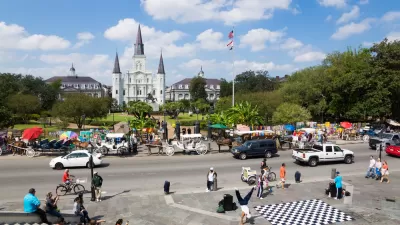Are there too many urban parks and plazas? If not, why do some fail? In this collaborative article, several urban planning gurus from different cities respond to these questions. They provide both shared and unique perspectives.
Jane Jacobs preferred the "ballet of the good city sidewalk" over urban parks. In fact, she was critical of many parks, as they existed in 1950s Robert Moses shaped New York City. Much has changed in park design since Jane Jacobs wrote The Death and Life of Great American Cities, and yet many of her prescriptions and warnings are as relevant as ever. In this article, five urban planning gurus—three from San Diego, one from NYC, and one from Portland OR—give their views about what makes a good urban park, both in general and in their particular city. The article concludes:
Design, location, context, programming, maintenance, unified planning, and other factors mean everything. . . Much has been learned from and since Jane Jacobs’ milestone of urban understanding about park design and location but urban parks do still on occasion fail. Jacobs warned against planning on the basis of statistics or metrics (“disorganized complexity”), e.g., one park per so many people or per so many square miles. A successful park depends on understanding the many interrelated elements in a neighborhood and successfully planning for them – including funding for maintenance and operation.
FULL STORY: Are cities building too many parks and plazas in their downtowns? The experts weigh in . . .

Alabama: Trump Terminates Settlements for Black Communities Harmed By Raw Sewage
Trump deemed the landmark civil rights agreement “illegal DEI and environmental justice policy.”

Study: Maui’s Plan to Convert Vacation Rentals to Long-Term Housing Could Cause Nearly $1 Billion Economic Loss
The plan would reduce visitor accommodation by 25% resulting in 1,900 jobs lost.

Planetizen Federal Action Tracker
A weekly monitor of how Trump’s orders and actions are impacting planners and planning in America.

Waymo Gets Permission to Map SF’s Market Street
If allowed to operate on the traffic-restricted street, Waymo’s autonomous taxis would have a leg up over ride-hailing competitors — and counter the city’s efforts to grow bike and pedestrian on the thoroughfare.

Parklet Symposium Highlights the Success of Shared Spaces
Parklets got a boost during the Covid-19 pandemic, when the concept was translated to outdoor dining programs that offered restaurants a lifeline during the shutdown.

Federal Homelessness Agency Places Entire Staff on Leave
The U.S. Interagency Council on Homelessness is the only federal agency dedicated to preventing and ending homelessness.
Urban Design for Planners 1: Software Tools
This six-course series explores essential urban design concepts using open source software and equips planners with the tools they need to participate fully in the urban design process.
Planning for Universal Design
Learn the tools for implementing Universal Design in planning regulations.
Caltrans
Smith Gee Studio
Institute for Housing and Urban Development Studies (IHS)
City of Grandview
Harvard GSD Executive Education
Toledo-Lucas County Plan Commissions
Salt Lake City
NYU Wagner Graduate School of Public Service





























